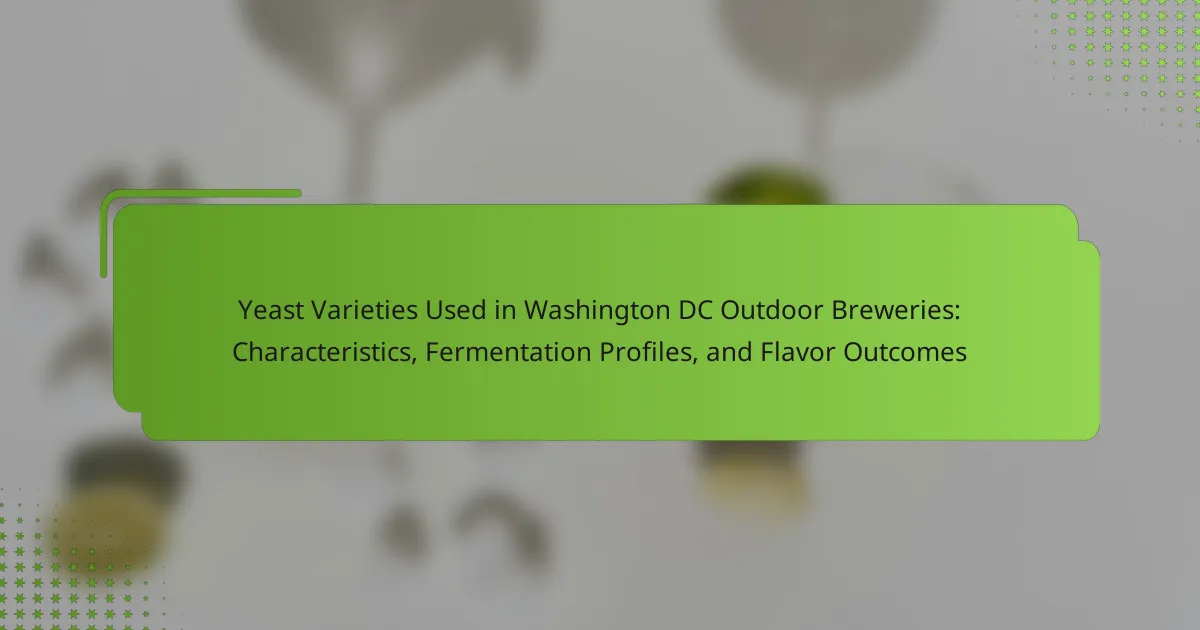Washington DC outdoor breweries utilize various yeast varieties, including Saccharomyces cerevisiae, Saccharomyces pastorianus, and Brettanomyces, each contributing distinct flavor profiles and fermentation characteristics. Saccharomyces cerevisiae is primarily used for ales, delivering fruity flavors, while Saccharomyces pastorianus is preferred for lagers, offering clean profiles. Brettanomyces adds complexity to sour beers with its unique characteristics. The article explores how local yeast strains are selected based on their adaptability to outdoor conditions, fermentation efficiency, and flavor contributions, highlighting the importance of yeast in crafting diverse beer styles that reflect the local brewing scene. Additionally, it discusses the significance of yeast attributes such as flocculation rates, alcohol tolerance, and resistance to environmental contaminants in ensuring high-quality outdoor brews.

What are the different yeast varieties used in Washington DC outdoor breweries?
Washington DC outdoor breweries utilize various yeast varieties, primarily including Saccharomyces cerevisiae, Saccharomyces pastorianus, and Brettanomyces. Saccharomyces cerevisiae is commonly used for ales, producing fruity and estery flavors. Saccharomyces pastorianus is favored for lagers, leading to clean and crisp profiles. Brettanomyces is often employed in sour beers, contributing complex and funky characteristics. These yeast strains are selected based on their fermentation profiles and the desired flavor outcomes. Each variety plays a crucial role in defining the unique taste of beers crafted in local breweries.
How do yeast varieties influence the brewing process?
Yeast varieties significantly influence the brewing process by affecting fermentation and flavor profiles. Different yeast strains produce varying levels of alcohol and carbon dioxide during fermentation. For example, Saccharomyces cerevisiae is known for its high fermentation efficiency and fruity esters. In contrast, Brettanomyces can impart unique flavors such as funkiness or earthiness.
The choice of yeast also impacts the beer’s aroma and mouthfeel. Certain strains can enhance hop character or contribute to a creamy texture. Additionally, yeast varieties can determine the fermentation temperature range, influencing the overall brewing timeline.
Research indicates that yeast selection can result in distinct flavor outcomes, shaping the final product’s identity. This variability underscores the importance of yeast in crafting unique beers.
What are the key characteristics of these yeast varieties?
The key characteristics of yeast varieties used in Washington DC outdoor breweries include fermentation temperature, attenuation, and flavor profile. Different yeast strains have optimal fermentation temperatures, typically ranging from 60°F to 75°F. Attenuation refers to the yeast’s ability to convert sugars into alcohol, with some strains achieving high attenuation rates above 80%. Flavor profiles vary significantly; some yeast strains impart fruity esters, while others contribute spicy phenols. Additionally, certain yeast varieties are known for their ability to produce unique aromas, enhancing the overall beer experience. These characteristics influence the final product’s taste and quality, making yeast selection critical in brewing.
How does yeast selection impact fermentation efficiency?
Yeast selection significantly impacts fermentation efficiency by influencing the rate of fermentation and the final product’s quality. Different yeast strains have varying fermentation kinetics, which affects how quickly sugars are converted into alcohol and carbon dioxide. For instance, some strains may ferment at higher temperatures, leading to quicker fermentation times. Others may produce higher levels of desirable flavors or aromas, enhancing the final product’s quality.
Research indicates that yeast strains can also affect the attenuation rate, which is the percentage of sugar converted to alcohol. High-attenuating yeasts can lead to drier beers, while low-attenuating strains may result in sweeter profiles. Furthermore, yeast health and vitality prior to fermentation play crucial roles in efficiency. Healthy yeast cells can metabolize sugars more effectively, reducing the risk of stalled fermentations.
In practical terms, breweries that choose the appropriate yeast strain based on their desired flavor profile and fermentation conditions can achieve optimal fermentation efficiency. Studies show that specific strains selected for particular styles can enhance both the fermentation process and the sensory characteristics of the final product.
What fermentation profiles are associated with various yeast strains?
Fermentation profiles vary significantly among different yeast strains. Each yeast strain contributes unique characteristics to the fermentation process. For example, Saccharomyces cerevisiae is known for its efficiency in converting sugars into alcohol, typically producing clean flavors and moderate esters. In contrast, Brettanomyces strains can produce funky, complex flavors due to their ability to utilize a wider range of sugars.
Lager yeast, such as Saccharomyces pastorianus, ferments at lower temperatures, resulting in a crisp and clean profile. This contrasts with ale yeasts, which ferment at warmer temperatures and often produce fruity esters and phenols. Additionally, specific strains like Belgian yeast can produce higher levels of phenolic compounds, contributing to spicy and clove-like flavors.
The fermentation profile is also influenced by factors such as temperature and oxygen availability. High temperatures can enhance ester production, while low oxygen levels can lead to different flavor outcomes. Understanding these profiles is crucial for brewers aiming to achieve desired flavor outcomes in their products.
How do different yeast strains affect fermentation temperature and duration?
Different yeast strains significantly influence fermentation temperature and duration. Each strain has a specific optimal temperature range for fermentation. For instance, ale yeast typically ferments best between 60°F and 75°F. In contrast, lager yeast thrives at cooler temperatures, usually between 45°F and 55°F.
The choice of yeast strain can also impact the fermentation duration. Ale fermentation often completes within one to two weeks. Lager fermentation generally takes longer, often extending to several weeks or even months.
Research indicates that yeast metabolism varies with temperature, affecting byproducts and fermentation speed. Higher temperatures may lead to faster fermentation but can produce unwanted flavors. Conversely, lower temperatures slow fermentation but enhance flavor clarity.
Thus, selecting the appropriate yeast strain is crucial for controlling both fermentation temperature and duration. This choice directly affects the final product’s flavor profile and quality.
What are the byproducts of fermentation from different yeast varieties?
The byproducts of fermentation from different yeast varieties include alcohol, carbon dioxide, and various flavor compounds. Saccharomyces cerevisiae primarily produces ethanol and carbon dioxide, making it ideal for brewing beer and fermenting wine. Other yeast strains, like Brettanomyces, can create unique flavors such as phenols and esters. Kluyveromyces lactis is known for producing lactic acid alongside ethanol, contributing to dairy fermentation. Each yeast variety’s metabolic pathway influences the specific byproducts generated during fermentation. These byproducts significantly impact the flavor and aroma profiles of the final products.
What flavor outcomes can be expected from using specific yeast strains?
Specific yeast strains can produce distinct flavor outcomes in brewing. For example, Saccharomyces cerevisiae often imparts fruity esters, such as banana and apple. This strain is commonly used in ales and can enhance the overall complexity of the beer. Conversely, Saccharomyces pastorianus, used in lagers, typically results in clean, crisp flavors with minimal fruity notes.
Belgian yeast strains, like Brettanomyces, can introduce funky, earthy, and spicy flavors. These strains often lead to a more complex flavor profile in Belgian-style beers. Furthermore, specific strains can influence mouthfeel and aroma, contributing to the overall sensory experience of the beer.
Research indicates that yeast selection significantly impacts beer flavor, as different strains produce varying levels of esters and phenols during fermentation. This variability allows brewers to tailor their products to specific flavor profiles.
How does yeast contribute to the aroma and taste of the final product?
Yeast contributes to the aroma and taste of the final product through fermentation by producing various compounds. These compounds include esters and phenols, which significantly influence flavor profiles. Esters often impart fruity notes, while phenols can add spicy or clove-like characteristics. The specific yeast strain used can determine the intensity and type of these flavors. For example, certain strains of Saccharomyces cerevisiae are known for producing banana and apple aromas. Additionally, yeast metabolism during fermentation can create byproducts such as diacetyl, which provides a buttery flavor. The fermentation temperature also affects the production of these aromatic compounds. Higher temperatures typically increase ester production, enhancing the overall aroma. Therefore, the choice of yeast and fermentation conditions are crucial in shaping the sensory qualities of the final product.
What are the flavor profiles of popular yeast varieties used in DC breweries?
The flavor profiles of popular yeast varieties used in DC breweries vary significantly. American Ale yeast typically imparts a clean, crisp taste with subtle fruity esters. Belgian yeast often contributes complex flavors, including banana and clove, along with a slightly spicy finish. Lager yeast provides a smooth, malty character with minimal fruitiness. Wheat yeast adds refreshing notes of banana and citrus, enhancing the beer’s overall brightness. Each yeast variety influences the final beer profile, making it essential for brewers to select the appropriate strain for their desired flavor outcome.
How do environmental factors influence yeast performance in outdoor settings?
Environmental factors significantly influence yeast performance in outdoor settings. Temperature affects yeast metabolism and fermentation rates. Optimal temperatures for many yeast strains range from 20 to 25 degrees Celsius. Higher temperatures can lead to increased fermentation speed but may also produce off-flavors. Conversely, lower temperatures slow down yeast activity, leading to incomplete fermentation.
Humidity levels impact yeast viability and growth. High humidity can promote contamination, while low humidity may stress yeast. Oxygen availability also plays a crucial role. Yeast requires oxygen for cellular respiration, especially during the initial growth phase.
Light exposure can affect yeast activity as well. Certain yeast strains are sensitive to UV light, which can inhibit growth. Additionally, the presence of various nutrients in the environment influences yeast performance. Nutrient-rich substrates enhance fermentation efficiency and flavor development.
Overall, these environmental factors interact to determine the overall effectiveness and flavor profile of yeast in outdoor brewing settings.
What role does temperature play in yeast activity during outdoor brewing?
Temperature significantly influences yeast activity during outdoor brewing. Yeast thrives within specific temperature ranges, typically between 60°F to 75°F. At optimal temperatures, yeast ferments sugars efficiently, producing alcohol and carbon dioxide. High temperatures can lead to faster fermentation but may also produce off-flavors. Conversely, low temperatures slow yeast activity, potentially resulting in incomplete fermentation. Research indicates that temperature fluctuations can stress yeast, affecting flavor profiles. For example, a study by Zainal et al. (2018) highlights that temperature control is critical for maintaining desired fermentation outcomes in brewing. Proper temperature management is essential for achieving the best flavor results in outdoor brewing.
How does humidity affect fermentation and flavor development?
Humidity significantly impacts fermentation and flavor development in brewing processes. High humidity levels can enhance yeast activity by providing a more favorable environment for fermentation. This increased yeast activity can lead to faster fermentation rates and more pronounced flavor profiles. Conversely, low humidity may slow down yeast activity, resulting in reduced fermentation efficiency and milder flavors. Research indicates that optimal humidity levels can lead to the production of esters and phenols, which contribute to complex flavor characteristics. Maintaining appropriate humidity is crucial for achieving desired flavor outcomes in beers produced in outdoor breweries.

What are the unique attributes of yeast varieties in Washington DC breweries?
Yeast varieties in Washington DC breweries exhibit unique attributes that influence flavor and fermentation. Many breweries utilize local strains that adapt to the region’s climate. These strains often produce distinct fruity or floral notes. Some yeast varieties are known for their high attenuation, resulting in drier beers. Others may contribute to a creamy mouthfeel due to their specific fermentation characteristics. Additionally, certain yeast types are prized for their ability to withstand higher alcohol levels. The diversity in yeast selection allows brewers to create a wide range of beer styles. This adaptability is essential for crafting unique local flavors that reflect the DC brewing scene.
What are the rare yeast strains found in local breweries?
Rare yeast strains found in local breweries include Brettanomyces, Kveik, and wild Saccharomyces strains. Brettanomyces is known for its unique flavors, often described as funky or earthy. Kveik yeast is a traditional Norwegian strain that ferments quickly at high temperatures. Wild Saccharomyces strains can contribute to complex flavor profiles and are often used in sour beers. These strains are not commonly found in mass-produced beers, making them rare in the brewing landscape. Their distinct characteristics add depth and variety to the craft beer market.
How do these rare strains differ from common varieties?
Rare strains exhibit distinct fermentation profiles compared to common varieties. These differences often result in unique flavor outcomes and aroma characteristics. Rare strains may have specific temperature tolerances that influence fermentation speed. They can also produce higher levels of certain esters and phenols, contributing to complex flavors. Additionally, rare strains might have lower attenuation rates, affecting the final gravity of the beer. Their genetic makeup often allows for unique metabolic pathways not present in common strains. Studies show that these variations can lead to innovative beer styles and enhanced sensory experiences.
What unique flavors do these rare strains produce?
Rare yeast strains produce unique flavors such as tropical fruit, floral notes, and spicy undertones. For instance, certain strains may impart flavors reminiscent of pineapple or mango. Others can introduce aromas similar to lavender or chamomile. Some rare strains are known for their peppery or clove-like spice. These flavors arise from the specific fermentation profiles of the yeast. Each strain’s metabolic processes contribute distinct esters and phenols. The unique flavor outcomes enhance the overall complexity of the brews. Washington DC outdoor breweries leverage these rare strains for innovative craft beers.
How do local brewing traditions influence yeast selection?
Local brewing traditions significantly influence yeast selection by dictating the types of flavors and aromas desired in the final product. Regional preferences often shape the choice of yeast strains that align with local beer styles. For example, traditional Belgian brewing employs specific yeast strains known for their fruity and spicy characteristics. Additionally, local climate and available resources can determine which yeast strains are viable for fermentation. Historical practices also play a role, as breweries may continue using strains passed down through generations. The unique attributes of local yeast strains can contribute to the distinctiveness of regional beers, enhancing their market appeal. This selection process is often guided by both tradition and innovation, leading to a diverse range of flavor outcomes.
What historical factors have shaped yeast usage in DC breweries?
Yeast usage in DC breweries has been shaped by several historical factors. The craft beer movement in the late 20th century spurred innovation in fermentation practices. Local breweries began experimenting with various yeast strains to create unique flavors. The influence of European brewing traditions introduced diverse yeast varieties. Additionally, the rise of homebrewing in the 1970s popularized yeast experimentation among enthusiasts. Regulatory changes in the alcohol industry also allowed for greater creativity in brewing. The proximity to research institutions facilitated collaboration on yeast studies. These factors collectively contributed to the distinctive yeast profiles found in DC’s breweries today.
How do local ingredients interact with yeast to create unique flavors?
Local ingredients interact with yeast to create unique flavors through various biochemical processes. Yeast metabolizes sugars present in local ingredients, producing alcohol and carbon dioxide. This fermentation process also generates esters and phenols, which contribute to flavor profiles. Different local ingredients provide distinct sugars, acids, and nutrients that influence yeast activity. For example, fruits can introduce specific sugars and organic acids, enhancing fruity flavors. Additionally, herbs and spices can impart unique aromatic compounds during fermentation. Research shows that the terroir, or environmental factors, of local ingredients affects yeast performance and flavor outcomes. This interaction results in a diverse range of flavors in beers produced in Washington DC outdoor breweries.

What best practices should be followed when selecting yeast for outdoor brewing?
Select yeast strains that are tolerant to outdoor temperature fluctuations. These strains can maintain fermentation activity in varying conditions. Choose yeast with high flocculation rates for clarity in outdoor brews. High flocculation helps in sedimentation and results in a cleaner final product. Opt for yeast that is known for robust flavor profiles suited to outdoor conditions. This enhances the overall taste experience of the brew. Consider local yeast strains adapted to the regional environment. Local strains often perform better in specific climate conditions. Ensure the yeast has a good attenuation range for desired alcohol levels. This supports consistent fermentation results. Lastly, prioritize yeast that is resistant to environmental contaminants. This reduces the risk of spoilage in outdoor settings.
What criteria should be considered when choosing a yeast strain?
When choosing a yeast strain, consider its fermentation characteristics. These include fermentation temperature range, attenuation, and flocculation properties. Fermentation temperature affects the flavor profile and aroma compounds produced. Attenuation indicates how much sugar the yeast can convert into alcohol. Flocculation refers to the yeast’s ability to clump together and settle after fermentation.
Also, consider the yeast strain’s flavor profile. Different strains produce varying esters and phenols, influencing the beer’s taste and aroma. The desired beer style will guide the selection of a compatible yeast strain.
Lastly, evaluate the yeast strain’s health and viability. Healthy yeast leads to consistent fermentation and better flavor outcomes. Research indicates that yeast health impacts fermentation speed and overall beer quality, making it a crucial factor in strain selection.
How can brewers optimize yeast performance in outdoor environments?
Brewers can optimize yeast performance in outdoor environments by managing temperature, oxygen levels, and nutrient availability. Maintaining a stable fermentation temperature is crucial, as yeast activity is temperature-sensitive. Brewers should monitor ambient temperatures and adjust brewing schedules accordingly. Providing adequate oxygen at the start of fermentation enhances yeast growth and vitality. Nutrient supplementation, such as adding yeast nutrients, supports yeast health and fermentation efficiency. Utilizing yeast strains suited for outdoor conditions can also improve performance. These strains may exhibit higher tolerance to temperature fluctuations and environmental stressors. Research indicates that specific yeast strains can enhance flavor profiles in outdoor brews, leading to unique taste outcomes.
What common challenges should brewers anticipate when using yeast outdoors?
Brewers using yeast outdoors should anticipate temperature fluctuations. These fluctuations can affect yeast activity and fermentation rates. High temperatures may lead to off-flavors and increased ester production. Low temperatures can slow fermentation and lead to incomplete fermentation. Additionally, outdoor conditions can introduce wild yeast and bacteria, impacting the intended flavor profile. Contamination from environmental sources can also occur, potentially ruining a batch. Lastly, humidity can influence the fermentation environment, complicating yeast management.
Yeast varieties used in Washington DC outdoor breweries, including Saccharomyces cerevisiae, Saccharomyces pastorianus, and Brettanomyces, play a critical role in defining beer flavors and fermentation profiles. This article explores the characteristics of these yeast strains, their influence on fermentation efficiency, and the unique flavors they produce. Additionally, it examines how environmental factors, local ingredients, and historical brewing traditions impact yeast selection and performance. The discussion also highlights best practices for choosing yeast strains in outdoor brewing settings, addressing common challenges brewers may face.
